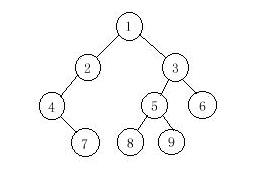杭电1710 Binary Tree Traversals(二叉树的遍历)
来源:互联网 发布:敏捷地产 知乎 编辑:程序博客网 时间:2024/05/01 01:58
Binary Tree Traversals
Time Limit: 1000/1000 MS (Java/Others) Memory Limit: 32768/32768 K (Java/Others)Total Submission(s): 3684 Accepted Submission(s): 1628
Problem Description
A binary tree is a finite set of vertices that is either empty or consists of a root r and two disjoint binary trees called the left and right subtrees. There are three most important ways in which the vertices of a binary tree can be systematically traversed or ordered. They are preorder, inorder and postorder. Let T be a binary tree with root r and subtrees T1,T2.
In a preorder traversal of the vertices of T, we visit the root r followed by visiting the vertices of T1 in preorder, then the vertices of T2 in preorder.
In an inorder traversal of the vertices of T, we visit the vertices of T1 in inorder, then the root r, followed by the vertices of T2 in inorder.
In a postorder traversal of the vertices of T, we visit the vertices of T1 in postorder, then the vertices of T2 in postorder and finally we visit r.
Now you are given the preorder sequence and inorder sequence of a certain binary tree. Try to find out its postorder sequence.

In a preorder traversal of the vertices of T, we visit the root r followed by visiting the vertices of T1 in preorder, then the vertices of T2 in preorder.
In an inorder traversal of the vertices of T, we visit the vertices of T1 in inorder, then the root r, followed by the vertices of T2 in inorder.
In a postorder traversal of the vertices of T, we visit the vertices of T1 in postorder, then the vertices of T2 in postorder and finally we visit r.
Now you are given the preorder sequence and inorder sequence of a certain binary tree. Try to find out its postorder sequence.

Input
The input contains several test cases. The first line of each test case contains a single integer n (1<=n<=1000), the number of vertices of the binary tree. Followed by two lines, respectively indicating the preorder sequence and inorder sequence. You can assume they are always correspond to a exclusive binary tree.
Output
For each test case print a single line specifying the corresponding postorder sequence.
Sample Input
91 2 4 7 3 5 8 9 64 7 2 1 8 5 9 3 6
Sample Output
7 4 2 8 9 5 6 3 1
Source
HDU 2007-Spring Programming Contest
/*加油!!!Time:2014-11-29 13:55*/#include<cstdio>#include<cstring>#include<algorithm>using namespace std;const int MAX=2005;typedef struct Tree{int num;Tree *lChild;Tree *rChild;}*tree;int pre[MAX],in[MAX],post[MAX];void Creat(tree &rt,int *pre,int *in,int len){//if(len==0)rt==NULL; //else{int p=-1;for(int i=0;i<len;i++){if(in[i]==pre[0]){p=i;break;}}//if(p==-1) rt=NULL;//else{rt=new Tree;rt->num=pre[0];if(p==0){rt->lChild=NULL;}else{Creat(rt->lChild,pre+1,in,p);//传入的是左右子树的第一个节点 //传入根节点,前序的根节点,中序的根节点,树的长度 }if(p==len-1){rt->rChild=NULL;}else{Creat(rt->rChild,pre+p+1,in+p+1,len-p-1);//右子树的第一个位置为pos+1 }//}//}}void Print(tree &rt,int &k){if(rt==NULL) return;Print(rt->lChild,k);Print(rt->rChild,k);post[k++]=rt->num;free(rt);}int main(){int n,i,j,k;while(scanf("%d",&n)!=EOF){memset(pre,0,sizeof(pre));memset(in,0,sizeof(in));memset(post,0,sizeof(post));for(i=0;i<n;i++)scanf("%d",&pre[i]);for(i=0;i<n;i++)scanf("%d",&in[i]);tree rt;k=0;Creat(rt,pre,in,n);Print(rt,k);//printf("k=%d\n",k);printf("%d",post[0]);for(i=1;i<k;i++)printf(" %d",post[i]);puts("");}return 0;} 0 0
- 杭电1710 Binary Tree Traversals(二叉树的遍历)
- hdu 1710 Binary Tree Traversals 二叉树的遍历
- HDU 1710(Binary Tree Traversals)二叉树的遍历
- HDOJ 1710Binary Tree Traversals 二叉树的遍历
- HDU---1710-Binary Tree Traversals (二叉树遍历)
- HDU 1710 Binary Tree Traversals (二叉树遍历)
- HDU--1710--Binary Tree Traversals(二叉树遍历)
- hdoj 1710 Binary Tree Traversals(二叉树的建立及遍历)
- HDU 1710 Binary Tree Traversals(二叉树的后序遍历)
- 数据结构之二叉树的遍历 HDU1710 Binary Tree Traversals
- HDU1710 Binary Tree Traversals(DFS,二叉树的遍历)
- hdu 1710 binary tree traversals 二叉树遍历
- 二叉树 遍历 hdu-1710-Binary Tree Traversals
- HDU-1710 Binary Tree Traversals 二叉树遍历
- (遍历二叉树)HDU 1710 Binary Tree Traversals
- hdu1710 Binary Tree Traversals(二叉树遍历)
- 【二叉树之遍历的应用】HDU 1710---Binary Tree Traversals
- 杭电 1710 Binary Tree Traversals
- "弹出DVD驱动器错误"解决方法
- hdoj杨辉三角
- 十四周项目二
- mini2440电源管理 suspend实现遇到的一些问题
- 关于孩子如何进行艺术教育的思考(一)
- 杭电1710 Binary Tree Traversals(二叉树的遍历)
- vc++MCF/C++/C中怎样让应用程序获得或以管理员权限运行 ,ShellExecuteEX编程 --- 获取管理员权限
- Web开发模式
- Boost在Windows上的配置以及的Boost::asio C/S同步例子
- 在注册控件时出现对DllRegisterServer的调用失败的解决办法
- hdu 2476 String painter (区间dp)
- vc中使用opencv
- ch5.JSP基本语法
- HDU2821Pusher(BFS+枚举)


